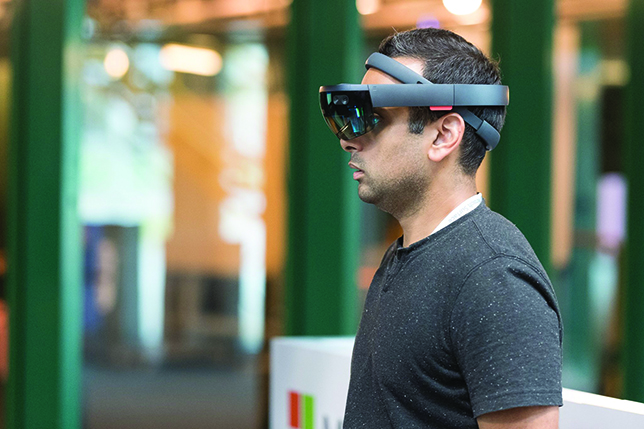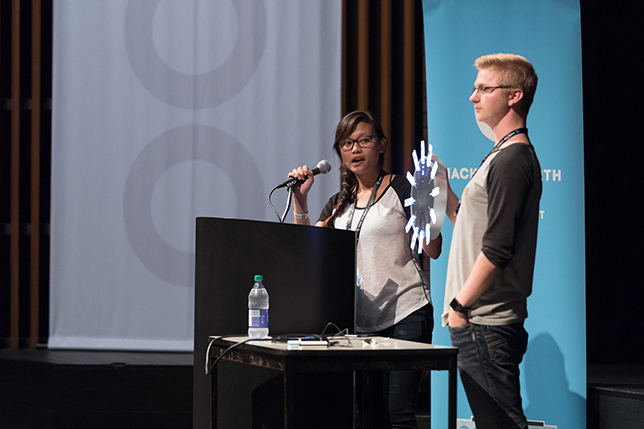It is 5:30 on Saturday morning, roughly 12 hours into Hack the North, counting the previous day’s registration, dinner, project pitches, overnight “fireside chats” and presentations from high-tech companies. Now, the six floors of the engineering building at the University of Waterloo are a jumble of students – hackers – slumped over keyboards, face down in front of monitors, or doggedly typing and mousing with a look around the eyes that begs the question: When did you last blink, let alone sleep? Still others are sprawled on or under tables, curled up in armchairs or stretched out on folding chairs. Many are wearing loose pyjama bottoms and free T-shirts bearing high-tech logos.
Hack the North is Canada’s largest hackathon, this year attracting 1,000 students from around the globe to U of Waterloo from September 16 to 18. The draw – roughly 5,000 students applied – is the opportunity to spend 36 hours creating computer software or hardware that might save the environment, help humanity or allow you to order pizza through a phone app that talks you through size, toppings and delivery of your order. The overall goal of the weekend is to develop a demo-ready program or project for judging by 10:30 Sunday morning.
“I haven’t slept in over a day, but I just want this to work so badly,” says James Hryniw, a 19-year-old civil engineering student from the University of Alberta. He dons a virtual reality headset, looks up, and starts laughing. “I’m looking straight up into the crotch of the avatar,” he says. That’s not the desired effect, acknowledges Nathan Doraty, a 21-year-old computer engineering major also from U of A. Mr. Hryniw and Mr. Doraty, along with Nicholas Westbury, 20, and Nathan Liebrecht, 19, are puzzling over how to connect the headset with a haptic (touch sensitive) virtual reality vest.

“If you wear the virtual reality headset and the vest, and stand in front of a Microsoft Kinect [a motion-sensing input device], which is also a camera, we can map the position of all your limbs,” Mr. Doraty explains. “If you get hit during a game of dodgeball, for example, you can see and feel where the ball hit you. It correlates. Since we are using two tracking systems – the Microsoft Kinect and Oculus Rift – we’re having trouble getting them to synch up properly without causing motion sickness.” Or an unintended peep show.
The team foresees their hack having applications in medical training and, ultimately, live surgeries. “The expert could be across the country and doing the surgery remotely, but still feel the surgery because human touch in this scenario is still so important,” Mr. Doraty says.
One floor up, U of Waterloo students Jamie Kim, 21, Emily Lam and Anna Dong, both 20, are waiting for a 3D printer to generate parts for their project. “We’re building a device that allows kids with motor disabilities to draw independently,” Ms. Lam says. She’d been thinking about this model for two months and saw the hackathon as her chance to develop it in a supportive space full of hackers, software experts and freely available technology.
“There’s only so much gratification in hand-over-hand assistance in drawing for a disabled child,” Ms. Lam says. “We want to take that guidance from above to below the drawing surface.” She envisions a device that guides a magnetized drawing tool across a screen. “Because of the neuroplasticity of the brain, this could potentially allow the child to develop new fine-motor skills,” Ms. Lam says. “This could be used with kids born with cerebral palsy, but also with stroke victims relearning a skill.”
Projects like this are the norm, not the exception, says Shy Ruparel. As a deputy commissioner with Major League Hacking, he helps organize student hackathons around the world. “Everybody thinks hackers are intent on developing games. But that would be the minority. There are lots of students working on websites, apps, robots. Hackathons are a great place to problem-solve.”
They also offer great prizes. Hack the North has $46,050 in cash and tech up for grabs, although Mr. Ruparel says that’s not what draws these students in. “Hackers aren’t here for the competition, but it does add structure to the event” he says. “Students are making stuff, learning and sharing. This is where the next founders of Facebook are. This is where the talent is.”
High-tech companies like Bloomberg, Microsoft, Google and Shopify know that and swarm to hackathons like this one. “We are here primarily to recruit,” says Kirusha Srimohanarajah, a developer with Synaptive Medical, a company specializing in neurosurgical technology. She’s also a U of Waterloo electrical engineering grad who was hired at Synaptive following a work-study term with the company. “We have thousands of people applying and it’s hard to compare resumés on paper,” Ms. Srimohanarajah says. “This is a good way for us to interact with students who took the initiative to be here.”
Software engineer Gloria Kimbwala is here recruiting for Square, a company that offers a mobile credit card payment system. “It’s easier to hire at these events because you see people who are passionate about solving problems,” she says. “Hackathons attract students from all kinds of disciplines, not just computer science but chemistry, mathematics, applied science, psychology – people who are interested in technology and building things.”
They’re also an opportunity for companies to get their new products into the hands of future developers, who will use, de-bug and – the hope is – fall in love with them. High-tech sponsors typically donate or loan an arsenal of hardware and software to these events.
By 6 a.m. Sunday, the goofing around, wisecracks and a lot – but not all – of the cockiness have evaporated. With just over four hours to go before judging, those who haven’t crashed physically or electronically are fiercely working to deadline. One sleep-frowzled hacker stares at a monitor repeating the command, “Alexa, tell the nurse to hand me the saw. Alexa …” in a flat monotone voice tinged with frustration.
By contrast, 23-year-old Brad Moon from U of Alberta is calmly applying finishing touches to the big Harry Potter-inspired Weasley Clock he and Michelle Mabuyo, 22, have made. In the book series, the clock magically tracks the whereabouts of each member of the Weasley wizard family, listing locations such as school, quidditch and “mortal peril.” The real-life version relies on the mobile operating system in a cellphone to track the whereabouts of a family or roommates with 12 muggle-appropriate options including school, work, in transit and invisible. “You could be on your way home and you see your roommate is getting groceries so you know you don’t have to stop at the store,” Ms. Mabuyo says. “Invisible is for the person who doesn’t want you to know where they are.”

“The emphasis here is definitely on learning,” says judge Danielle Strachman, a partner at 1517 Fund, a venture capital company. “Did they learn something new here, did they try something challenging for themselves or did they just keep building on something they already know? That’s a big part of why this community exists. They really want people to try new things, to stretch and challenge themselves.”
You don’t come down easily from an event like Hack the North, so even after the judging, a lot of participants were still thronging the sponsor and product display area to have one last look, score one last piece of swag – branded water bottles, portable phone chargers, stress balls and other giveaways were still in abundant supply – or chat up a few more potential contacts.
“I’m just walking around talking to people,” said 22-year-old Alex McVitte, who suddenly remembered Sunday was his birthday. “You never know what a conversation here is going to lead to. Plus I’m still pretty hyped up on caffeine and Red Bull.”